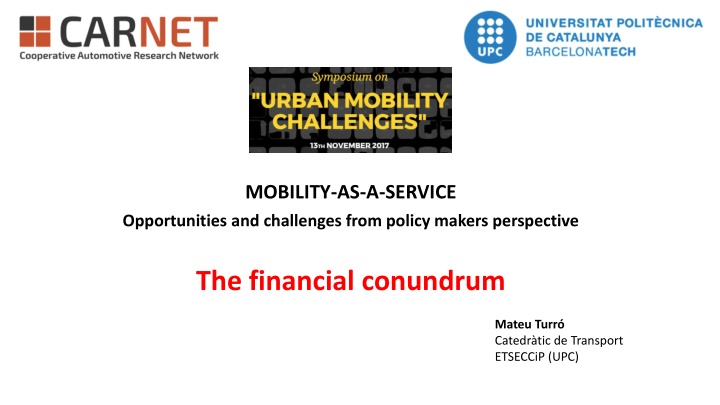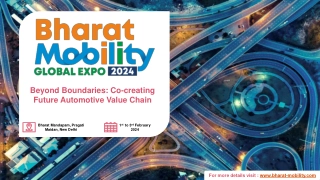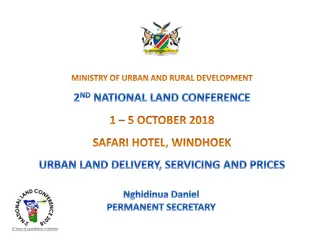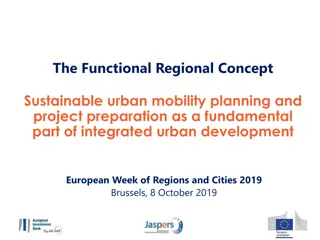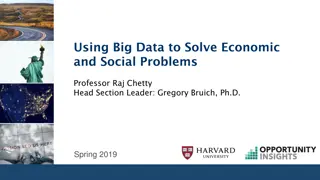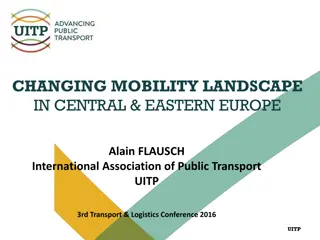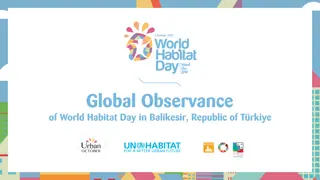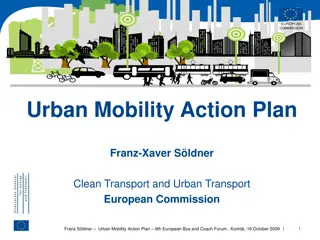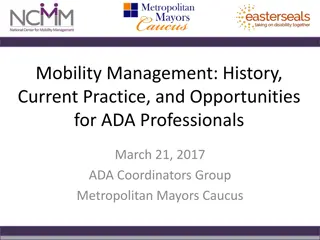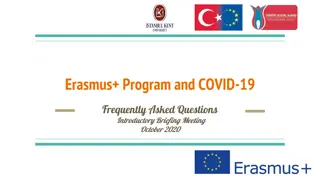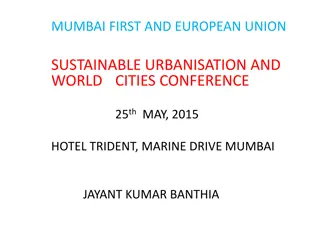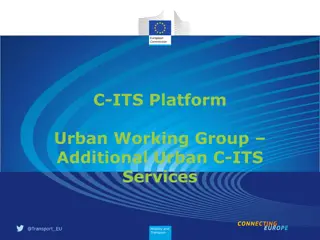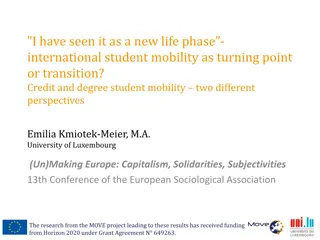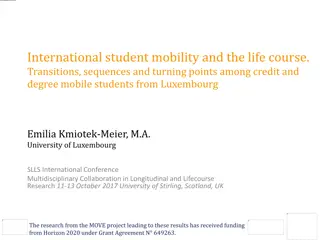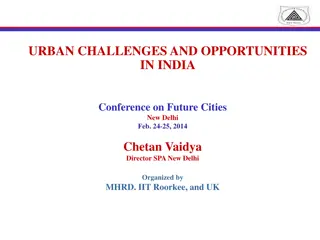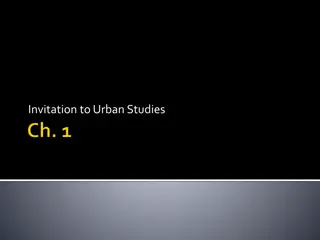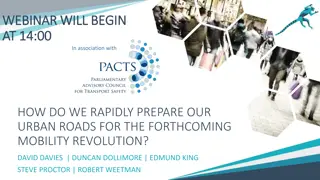Challenges in Urban Mobility-as-a-Service
Financial conundrum in Mobility-as-a-Service (MaaS) from the perspective of policy makers. Addressing the complexities of payment models, social accessibility, and financing dilemmas in urban transportation. Delve into the principles of charging criteria for mobility services and the current financial equation of Urban Public Transport (UPT)."
Download Presentation

Please find below an Image/Link to download the presentation.
The content on the website is provided AS IS for your information and personal use only. It may not be sold, licensed, or shared on other websites without obtaining consent from the author.If you encounter any issues during the download, it is possible that the publisher has removed the file from their server.
You are allowed to download the files provided on this website for personal or commercial use, subject to the condition that they are used lawfully. All files are the property of their respective owners.
The content on the website is provided AS IS for your information and personal use only. It may not be sold, licensed, or shared on other websites without obtaining consent from the author.
E N D
Presentation Transcript
MOBILITY-AS-A-SERVICE Opportunities and challenges from policy makers perspective The financial conundrum Mateu Turr Catedr tic de Transport ETSECCiP (UPC)
Mobility-as-a-Service (MaaS) Tailored and integrated end-to-end trip planning, booking, electronic ticketing, and payment services across all modes of transport, public or private It is the user view of the SMART MOBILITY concept that takes advantage of a joint approach to new transport and telecommunications technologies A deep transformation with important social and territorial impacts that confronts us with the need to rethink present pricing and business models
MaaS in the urban context Urban mobility as a public service Urban mobility as a public service Ensure minimum level of personal accessibility Ensure minimum level of personal accessibility Location and social issues Location and social issues Personal conditions (age, handicapped, social?) Personal conditions (age, handicapped, social?) Ensure efficient freight deliveries Ensure efficient freight deliveries Optimisation Optimisation of commercial transport supply of commercial transport supply P Public sector ublic sector regulation: regulation: Efficiency Efficiency and efficacy and efficacy Affordability and Affordability and fair fair distribution of costs and distribution of costs and benefits benefits
Paying for MaaS What are the charging criteria for mobility services? What are the charging criteria for mobility services? Principles: Principles: User pays and polluter pays but, under excludability of use (congestion) and urban constraints (limited land supply and externally-marked schedules), how can they be applied? Modal split and Urban Public Transport (UPT) tariffs Paying for social services The complexity of externality valuation Commercial activities should be fully charged? The financing dilemma: Who should pay for what? The financing dilemma: Who should pay for what? Multiple uses for transport infrastructure
UPT present financial equation Families spend 12-15% of budget on transport Automobile (purchase 3-6%; operation around 7% - substantial part urban) Services (1-1.7% depending on urban size); UPT in Catalonia: 0.6-0.7%) Public sector expenditure covers: Infrastructure (mixed streets- and UPT) Public parking Traffic management Subsidies to UPT operation Public sector get revenues from: Taxes on vehicle ownership Parking-related charges Tolls (in a few cases) Other (fines, fees, etc.) There is no clear link between any of There is no clear link between any of these financial flows these financial flows
Prospective of Mobility-as-a-Service (MaaS) Without a clear regulatory and financial model the constraints of space and time (possibly reduced) will lead to severe congestion (NY and ber) The autonomous vehicle (AV) could liberate requirements for space. Combined with shared mobility could reduce street space requirements to 10/15% of present needs. Possible flying autonomous taxis? Even with increased mobility (non-drivers, new demand), a reasonable fleet of AV could serve a substantial part of individual trips UPT will have to be adapted and be considered part of an integrated public- private system The development of e-commerce will represent a great increase in the number of commercial trips and devoted urban space. Fast development but price sensitive, although home reception matters; 80% of deliveries with AV in 10 years (Mc Kinsey report).
Proposed objectives for MaaS A) To provide the required levels of urban mobility to all citizens (in reasonable A) To provide the required levels of urban mobility to all citizens (in reasonable locations) in terms of time and cost. This means a provision of UPT and/or AV in locations) in terms of time and cost. This means a provision of UPT and/or AV in an efficient combination at an affordable price. an efficient combination at an affordable price. B B) To recover the conviviality of the city through traffic calming ) To recover the conviviality of the city through traffic calming and elimination of most curb parking and elimination of most curb parking and thus thus recovery of public involves substantial investments to adapt existing infrastructure and the loss of involves substantial investments to adapt existing infrastructure and the loss of parking revenues. parking revenues. C C) Improve the urban environment with the rapid deployment of electric motor ) Improve the urban environment with the rapid deployment of electric motor vehicles (in UPT and AV vehicles (in UPT and AV). ). D) To facilitate fast transport to individuals with high travel time value and to D) To facilitate fast transport to individuals with high travel time value and to commercial activities that should pay fully for their use of public space and for commercial activities that should pay fully for their use of public space and for traffic management. traffic management. and the space. This the recovery of public space. This
A financing model for MaaS Transport planning and regulations will have to take into account the new paradigm. The present financial equation must be revised to introduce some logic into the model, based on accepted (user/polluter) principles but supporting other objectives Non-mobility objectives (social, promotional, etc.) should be covered by ad-hoc budgets The selection of funding sources should seek an appropriate funding blend such that total revenues for Maas are sufficient, stable and predictable. Commercial activities should cover their full costs
A financing model for MaaS Cost reduction of UPT with the use of autonomous vehicles to run services with Cost reduction of UPT with the use of autonomous vehicles to run services with thin demand and a new concept of UPT providing accurate travel information thin demand and a new concept of UPT providing accurate travel information and extreme reliability and extreme reliability Information to users on expected trip costs of various alternatives. Information to users on expected trip costs of various alternatives. Payment through T Payment through T- -mobility type of mechanism (Control and privacy issues) mobility type of mechanism (Control and privacy issues) New approach to charging for the use of private vehicles New approach to charging for the use of private vehicles Consolidation of mobility revenues and costs in a single Mobility Agency Consolidation of mobility revenues and costs in a single Mobility Agency Better decision Better decision- -making and management of mobility infrastructure, making and management of mobility infrastructure, incorporating land incorporating land- -value capture and other fair funding mechanisms value capture and other fair funding mechanisms Contribution to non-transport objectives (i.e. social) would entail specific public budget contributions.
Research underway at CENIT/UPC Innovative financial models for UPT Innovative financial models for UPT FINANCIAL INSTRUMENTS FOR UPT FUNDING FINANCING Public-private partnership (PPP) General Taxation (public budget) Green taxation Land value capture Revenue strategies Commercial value Debt facilities Investment Improvement Services
Research underway at CENIT/UPC Application of an innovative toll charging mechanism in Barcelona Application of an innovative toll charging mechanism in Barcelona Pay per use Pay per use In parallel with In parallel with superilles superilles Pay for speed, implies a new traffic management model Pay for speed, implies a new traffic management model From Singapore s Land Transport Authority
Research underway at CENIT/UPC Application of an innovative toll charging mechanism in Barcelona Application of an innovative toll charging mechanism in Barcelona It has been estimated that, depending on the toll applied (from 5 to 18 cents/km): The reduction in daily vehicles would be between 400000 and 600000 The toll money collected between 100 and 300 million /year The additional money collected by UTP due to modal transfer between 100 and 170 million /year.
Research underway at CENIT/UPC Out Out- -of of- -street parking for autonomous vehicles street parking for autonomous vehicles Design (charging, cleaning, etc.) for shared mobility AV parking areas Design (charging, cleaning, etc.) for shared mobility AV parking areas Modelling the optimal location and number of places according to demand Modelling the optimal location and number of places according to demand An urban problem (in the USA 15 An urban problem (in the USA 15- -30% of all urban space devoted to parking; 30% of all urban space devoted to parking; up to 90% of it might become unnecessary) up to 90% of it might become unnecessary) In Barcelona: existing off In Barcelona: existing off- -street street parkings parkings, new commercial space. commercial space. E E- -commerce commerce Space needs (related to parking Space needs (related to parking) ) Charging per use to Charging per use to optimise optimise the delivery process the delivery process E E- -commerce should pay full costs. Need to evaluate demand and costs. commerce should pay full costs. Need to evaluate demand and costs. , new specialised specialised areas, first floors for areas, first floors for
Conclusion We are confronted with a radical change in urban mobility The financial equilibrium will be severely affected Regulatory measures are necessary New financial schemes must be proposed to optimise MaaS
